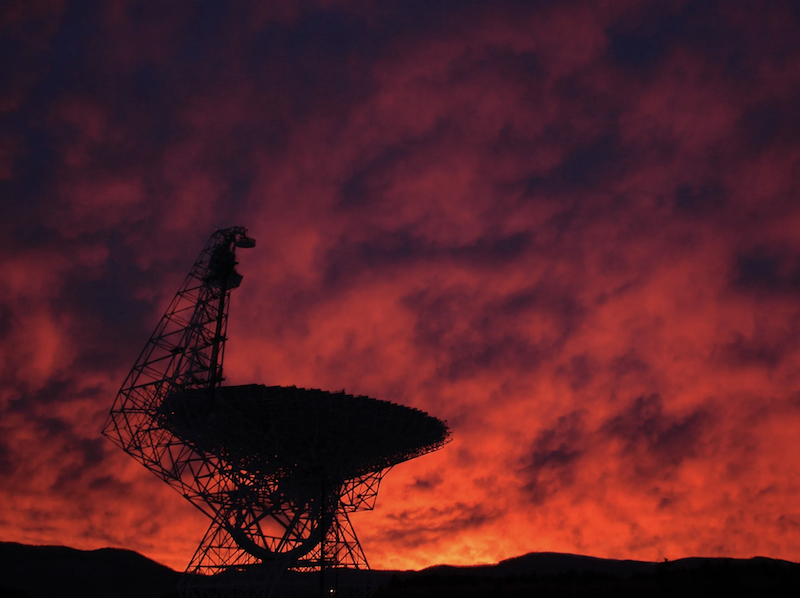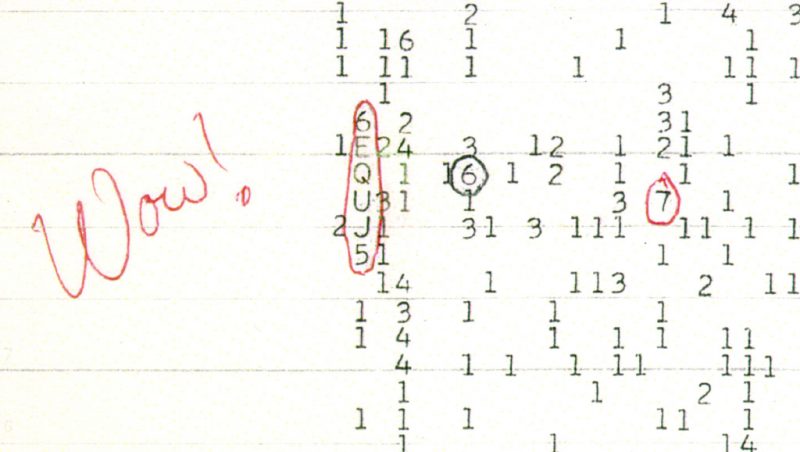
An international team of researchers, led by scientists at the University of Toronto, has developed a new machine learning algorithm to help answer one of the biggest questions of all: Are we alone in the universe? It’s another use of artificial intelligence (AI), in which a computer performs tasks humans (or less sophisticated computers) used to do. The researchers announced the news on January 30, 2023. They hope their new algorithm will streamline the search for extraterrestrial intelligence, commonly known as SETI. It can find potential signals in data that other methods might have missed. And in fact, after looking at 820 initial stars, it has already found 8 potential signals of interest.
The astronomers discovered the signals in radio data previously collected by the Robert C. Byrd Green Bank Telescope in West Virginia. The telescope collected the data as part of the Breakthrough Listen initiative. Scientists had missed the tentative signals in earlier examinations of the data.
The researchers published their work in a new peer-reviewed paper in Nature Astronomy on January 30, 2023. A preprint version of the paper is also available from UC Berkeley SETI.
In addition to the University of Toronto, the SETI Institute and Breakthrough Initiatives also issued their own press releases.
New AI search for aliens: Separating wheat from chaff
Throughout the history of SETI, interference from human-caused radio signals has been a a persistent problem. Finding actual extraterrestrial signals – if they are out there – is not an easy task. Peter Ma, an undergraduate at the University of Toronto and lead author of the new paper, stated:
In many of our observations, there is a lot of interference. We need to distinguish the exciting radio signals in space from the uninteresting radio signals from Earth.
Hence, astronomers needed a new method of detecting radio signals or other technosignatures, one that could “separate the wheat from the chaff” as it were. That is where Ma and his team come in. They developed a new machine learning algorithm that can better pick out potential alien signals from all the background noise on Earth. This initial search combed through data from 820 nearby stars. The paper said:
Here we present a comprehensive deep-learning-based technosignature search on 820 stellar targets from the Hipparcos catalog, totaling over 480 hours of on-sky data taken with the Robert C. Byrd Green Bank Telescope as part of the Breakthrough Listen initiative.
The SETI Institute also quoted Ma:
In total, we had searched through 150 TB of data of 820 nearby stars, on a dataset that had previously been searched through in 2017 by classical techniques but labeled as devoid of interesting signals.
Alien signals vs. human-caused interference
So, how does this machine-learning tool work? Basically, the researchers trained the algorithm to differentiate between potential alien signals and human-caused ones by simulating both types of signals.
The new algorithm is based on comparisons of various other machine-learning algorithms. The goal is to decrease false-positive rates and increase precision in detecting bonafide signals. Steve Croft, project scientist for Breakthrough Listen on the Green Bank Telescope, added:
The key issue with any technosignature search is looking through this huge haystack of signals to find the needle that might be a transmission from an alien world. The vast majority of the signals detected by our telescopes originate from our own technology: GPS satellites, mobile phones and the like. Peter’s algorithm gives us a more effective way to filter the haystack and find signals that have the characteristics we expect from technosignatures.
AI search for aliens yields 8 ‘signals of interest’
The algorithm may be new and still being tested, but it has already discovered eight signals of interest. The astronomers searched 820 nearby stars from the Hipparcos catalogue for possible technosignatures. And surprisingly, it has already found … something. The eight signals appear to originate from the direction of five of the stars, ranging from 30 to 90 light-years away. Researchers did not see them in previous analysis of the data, which did not use the machine learning technique. While not proven to be extraterrestrial, they are certainly interesting. Croft said:
First, they are present when we look at the star and absent when we look away, as opposed to local interference, which is generally always present. Second, the signals change in frequency over time in a way that makes them appear far from the telescope.
They look like alien signals … but are they?
The researchers noted that the signals have key characteristics that make them worth a closer look:
1. The signals were narrowband, meaning they had narrow spectral width, on the order of just a few Hz. Signals caused by natural phenomena tend to be broadband.
2. The signals had non-zero drift rates, which means the signals had a slope. Such slopes could indicate a signal’s origin had some relative acceleration with our receivers, hence not local to the radio observatory.
3. The signals appeared in ON-source observations and not in OFF-source observations. If a signal originates from a specific celestial source, it appears when we point our telescope toward the target and disappears when we look away. Human radio interference usually occurs in ON and OFF observations due to the source being close by.
The signals look like what scientists expect extraterrestrial signals would likely be like. There’s one problem, though. Follow-up observations – so far, anyway – didn’t see them again. The astronomers need to detect them again in order to study them more closely and try to determine if they actually are from deep space or just terrestrial interference. The paper states:
Our work also returned eight promising extraterrestrial intelligence signals of interest not previously identified. Re-observations on these targets have so far not resulted in re-detections of signals with similar morphology.
Accelerating the search for technosignatures
Even though these eight signals are intriguing, yet unconfirmed, they show that the new algorithm is working. Astronomers will be able to apply it to other datasets as well. As co-author Cherry Ng noted:
By poking the data with every technique, we might be able to discover exciting signals. I am impressed by how well this approach has performed on the search for extraterrestrial intelligence. With the help of artificial intelligence, I’m optimistic that we’ll be able to better quantify the likelihood of the presence of extraterrestrial signals from other civilizations.
Ma added:
With our new technique, combined with the next generation of telescopes, we hope that machine learning can take us from searching hundreds of stars to searching millions.

More promising than the Wow! signal?
Analysis of the original signals is continuing, however. Even though they may well turn out to be yet another case of earthly interference, they are potentially promising. Astronomer Michael Garrett at the Jodrell Bank Center for Astrophysics, University of Manchester, said:
A cursory review of the new paper suggest these are indeed promising signals. They’re much more compelling than what is perhaps the most famous SETI candidate, the Wow! signal, radio emission bearing the hallmarks of an extraterrestrial origin that was collected by an Ohio telescope in 1977. Realistically, it’s most likely that these eight new signals were generated by human technology. But the real story here is the effectiveness of AI and the techniques used by the team to dig out rare and interesting signals previously buried in the noise of human-generated radio frequency interference, such as mobile phones and GPS.
The researchers will continue to look at the stars where the signals appeared to come from, according to Breakthrough Initiatives Executive Director S. Pete Worden:
We’ll continue to monitor the stars Peter observed, and we’ll continue to develop our use of artificial intelligence to help us try to answer humanity’s most profound question: Are we alone?
Astronomers previously detected Breakthrough Listen’s first candidate signal, called BLCI, in 2020. It seemed to come from the direction of the closest star to the sun, Proxima Centauri, but was later traced to earthly interference.
Bottom line: An international team of scientists said that a sophisticated new AI search for aliens has already found 8 potential signals of interest from 5 nearby stars.
Source: A deep-learning search for technosignatures from 820 nearby stars
Source (preprint): A deep-learning search for technosignatures of 820 nearby stars











